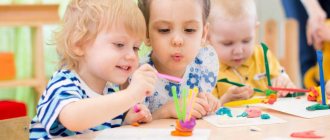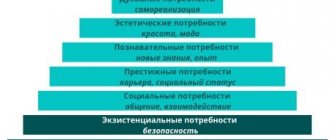As the child grows and develops, the scope of his capabilities constantly expands. Over time, he experiences a transition from primitive manipulations with objects to more conscious activities. Various types of leading activities in infancy can have a positive impact on the psychological development of the child and form him into a truly versatile and interesting person. Any changes that occur during this period of time have a strong impact on the formation of the baby and the process of developing his personality.
Characteristics
Pediatricians and psychologists have identified the main distinctive features of the leading activities of a child in infancy:
- help the baby develop a number of new actions that he will fully master in the future;
- with their help, the emergence and restructuring of certain functions of the psyche of a growing baby occurs;
- influence the personality and make visible changes in it.
The mental development of a child depends on the appropriate type of leading activity. When changing activities, one can clearly say that the child has moved to another, more advanced stage of his development.
Definition and features of the concept
Leading activity is the type of activity of the child that, at a certain stage of his growing up, has a key influence on him. Each stage has its own options for activities and all parents are required to clearly know them. Note that this is not one specific type of action, but a complex of them. Mastery of each of these actions helps the child seamlessly move to the next stage of development. For all children, the age from birth to approximately six to seven years is particularly critical in terms of their emotional, psychological and physical development, as well as the process of their socialization.
It is important that the child’s leading activity in each of the periods, which we will talk about a little further, corresponds to his mental and psycho-emotional capabilities
Structure and main varieties
The process of human mental development in the period from infancy to preschool age is classified into three separate structures:
- persisting – moved from the previous stage;
- direct – determines the current stage of leading activity;
- nascent is a stage that is only at the initial stage of its development and will be the main one at the next stage.
Experts include the following among the leading types of activity in infancy and in subsequent periods:
- direct communication of the child with adults and people around him through emotions (age range from birth to one year);
- object-manipulative (from one to three years);
- play (from three years to the start of school).
For schoolchildren aged 6 to 11 years, the priority is the educational process, and for adolescents aged 11 to 15 years, communication with peers is the priority. The most important period of development for a child is the period from 0 to 7 years.
Early age
Yaroslavtseva Svetlana
Early age
Introduction
The position on the importance of the social environment and the child’s communication with adults and peers for mental development and personality formation is generally recognized in modern psychology. However, the question of the mechanisms of influence of the social environment on human development is interpreted differently depending on the theoretical model of development adopted in various schools and directions - behavioral psychology, social learning theory, epigenetic approach, model of ecological systems, psychology of operational development of intelligence, cultural-historical approach. In the doctrine of the structure and dynamics of psychological by L. S. Vygotsky introduced the concept of the social situation of development as the most important characteristic of age , revealing the relationship between the child and his social environment. The age specificity and content of the category social situation of development at stable and crisis ages were subjected to in-depth theoretical and experimental analysis in the works of domestic psychologists (L. I. Bozhovich, V. V. Davydov, M. I. Lisina, D. B. Elkonin, D. I. Feldshtein, etc.). It was shown that the features of the social situation of development decisively determine the direction, content and nature of the child’s development in the normative space of age-related development . At the same time, in modern child psychology there is an increasingly acute awareness of the need to specify the concept of “social situation of child development”
both theoretically and to solve urgent and important problems of optimization, prevention and correction of children’s mental development.
Early age covers the period from 1 to 3 years and is one of the key ones in a child’s life. It is characterized by a new social situation of development, since at this stage of his life the leading subject becomes ethno-manipulative activity, which replaces emotional communication with an adult (the leading activity of the infant; important new formations arise.
Social situation of development in early childhood .
The special significance of early childhood lies in the fact that it is directly related to walking. The ability to move, while a physical asset, has tangible mental consequences. Thanks to her, he begins to walk freely and communicate more independently with the outside world. Walking develops the ability to navigate in space, expands the ability to become familiar with the environment, and also provides a transition to independent objective activity. The baby is completely absorbed in objects, as a result of which his relationships with adults change. Emotional communication with them is becoming less and less common, giving way to situationally effective communication, practical cooperation, and joint actions with objects. An adult, as a rule, is disposed to communicate due to his business qualities, and not his emotionality. The social situation of development in early childhood has the following structure: “child - object - adult”.
Leading activities in early childhood .
For early childhood, the main activities are object activity, speech and play. The development of objective activity is associated with the mastery of methods of using objects developed by mankind. A child learns from adults how to use objects and understands the meaning of things. The difference between object-based activity and the simple manipulation of objects characteristic of the infant period lies in the subordination of the child’s methods of action with objects to their functional purpose in the life of a cultured person.
The means of carrying out objective activity, the instrument of mastering social ways of using objects, is communication. Despite the fact that emotional communication ceases to be a leading activity in early childhood , it continues to develop very intensively and becomes verbal. After all, communication connected with objective actions cannot only be emotional; it must be mediated by words.
Early age is sensitive (favorable)
period for speech development since it is at this time that language acquisition is effective.
By the age of three, the child masters speech breathing, all the sounds of his native language are given, his vocabulary is 1200-1500 words, he does not use common sentences (5-6 words, which indicates the mastery of the basics of syntax, he is active in verbal communication with adults and children, masters expressive and facial actions (smile, eye contact, movements, postures, touches, etc.)
If a child for some reason does not have the necessary conditions for speech development, then it is very difficult to catch up later. In the first year of life, it is necessary to especially and intensively engage in speech development.
For the development of a child, play is of particular importance - an activity aimed at orientation in objective and social reality.
Elements of the game are already used by infants, manipulating objects (toys, pacifiers)
.
In the second year of life, play becomes more spontaneous and meaningful. It is not just manipulation, but unfolds as an action with objects in which the child reproduces what adults do (for example, talking on the phone, drinking tea)
.
These are the first steps on the path to symbolic actions, common types of games at this age are pre-exploration play (playful exploration of the features of objects, construction play (independent construction of structures and playing with them, role-playing play ( child taking on the role of an adult)
game.
There are different views among researchers regarding the causes and purposes of play. Supporters of psychoanalytic theory, for example, believe that role-playing play helps a child cope with conflicts. However, being reflected in the game, psychological conflicts are not always its cause. If, while playing with a doll, a child cares deeply about it, it is quite possible that this expresses her need for love and compensates for the lack of parental warmth.
The child’s play activity is the basis for the formation of future skills and mental actions. In the process of gaming experimentation, many new complex abilities are formed. Up to two years old, children can already play elementary logic games (involve the use and development of logical thinking skills)
and thematic
(assigned by adults or independently
chosen ) games, demonstrating their ability to draw up an action plan.
With the development of symbolic (conventional designation in the game of objects, events, phenomena)
games change the child’s attitude towards other children. In the first year of life, they hardly interact with each other; children treat each other like living toys: they pull their hair, touch their eyes with their fingers, etc. At 18-20 months, they begin to interact with play partners and strive to play with each other. with a friend.
So, objective activity, speech and play indicate the mental development of the baby. These types of activities reveal certain mental neoplasms of early childhood .
Characteristics of full communication young child and adults :
— initiative towards the elder, the desire to attract his attention to his actions;
- preference for substantive cooperation with an adult, insistent demand from an adult for complicity in their affairs;
- gullibility, openness and emotionality in relation to an adult, showing love for him and a willing response to affection;
- sensitivity to the attitude of an adult, to his assessment and restructuring of one’s behavior depending on the behavior of an adult, a subtle distinction between praise and blame;
- active use of speech in interaction.
The social situation of development is “a completely unique, specific for a given age , exclusive, unique and inimitable relationship between the child and the reality around him, primarily social.”
An age crisis is a special period of transformation of the social situation of development: a new formation of the previous period destroys the old development situation and provokes the formation of a new one. According to Vygotsky, the age crisis is the norm of ontogenesis.
The concept of a social situation of development was introduced by L. S. Vygotsky as a unit of analysis of the dynamics of a child’s development, that is, a set of laws that determine the emergence and changes in the structure of a child’s personality at each age stage . The social situation of development determines the child’s lifestyle, his “social being”
, during which they manifest new personality traits and develop new mental formations.
Being a product of age-related development , neoplasms appear towards the end of the age period and lead to a restructuring of the entire structure of the child’s consciousness, to changes in the system of his relationships to the world, other people, and himself. The appearance of new formations is a special sign of the collapse of the old social situation of development and the formation of a new social situation of development, which is accompanied by crises of age-related development . The concept of social situation of development was defined by B. G. Ananyev and, in his opinion, it is aimed at overcoming ideas about the environment as a factor that mechanically determines the development of the individual. Subsequently, this concept received a detailed analysis in a macro-social-psychological context and was used to describe, for example, the ontogenetic development of a child’s personality by L. I. Bozhovich, D. B. Elkonin, who defined age characterized by the following main indicators:
1) a certain social situation of development - the specific form of relationships that a child enters into with adults in a given period;
2) main or leading type of activity;
3) the main mental new formations acquired at this stage of development (from individual mental processes to personality traits)
. And also as a relatively closed period, the significance of which is determined primarily by its place on the general curve of child development.
Thus, the social situation of development is specific for each age period , determined by the system of relations of the subject in social reality, reflected in his experiences and realized by him in joint activities with other people.
Object of study: children from infancy to adolescence .
Social situation of infant development.
This situation is determined by the complete helplessness of the baby and the absence of any means of independent existence and satisfaction of its needs. The only such “means”
there is another person - an adult who mediates absolutely all the manifestations of the baby. Whatever happens to the baby, he is always in a situation related to the adult caring for him. Objects appear and disappear from the child’s field of vision always thanks to the participation of other people; the child always moves in space on someone else’s legs and arms; the elimination of irritants that interfere with the baby and the satisfaction of his basic needs is always accomplished through other people.
he designates the main neoplasm of infancy with “couple - we”
, and implies by it the original mental community of mother and child.
Harmony and synchronicity of interaction between mother and child are the most important fact of the psychology of infancy. This fact suggests that not only the child “adapts”
to the mother, but she also adapts to the child’s actions. The child and mother mutually change and develop each other. It is in this ability for harmonious interaction and in the general disposition to communicate with adults that the baby’s activity is manifested.
Social situation of development at an early age .
At the end of the first year of life, the situation of unity between the child and the adult explodes from the inside. Two opposite but interconnected poles appear in it - a child and an adult. By the beginning of early childhood, the child , acquiring the desire for independence and independence from the adult, remains connected with the adult and objectively (since he needs the practical help of an adult)
and subjective
(since it needs an adult’s assessment, his attention and attitude)
. This contradiction finds its resolution in the new social situation of the child’s development, which represents cooperation, or joint activity of the child and the adult.
Communication between a child and an adult begins to be mediated by objects already in the second half of infancy. However, the child isolates only individual objects and considers the adult himself as an interesting object. In the second year of life, the content of the child’s substantive cooperation with an adult changes radically. The content of their joint activity is the assimilation of socially developed ways of using objects. The uniqueness of the new social situation of development, according to D. B. Elkonin, lies in the fact that now the child does not live with an adult, but through an adult, with his help. The adult does not do it instead of him, but together with him.
The content of communication becomes extra-situational, going beyond the perceived situation.
M.I. Lisina identified two non-situational forms of communication characteristic of preschool age - cognitive and personal.
In the first half of preschool age (3 - 5 years)
An extra-situational-cognitive form of communication between a child and an adult appears.
Unlike the previous one (situational business),
it is woven not into practical cooperation with an adult, but into
“theoretical” (why this is so)
.
Since it is not the situation that is being discussed, communication for the first time acquires an extra-situational character.
By the end of preschool age, a new and highest for preschool age - an extra-situational-personal form of communication. Unlike the previous one, its content is the world of people, not things. A preschooler is interested in a variety of aspects of an adult’s existence that are not visible in a specific situation and do not concern the child himself (where he lives, who he works for, whether he has children, etc.)
.
He talks just as willingly about himself (about his parents, friends, joys and grievances)
.
The need for mutual understanding and empathy of an adult is the main one for extra-situational-personal communication.
The contradiction in the social situation of a preschool child’s development lies precisely in the gap between his desire to be like an adult and the impossibility of realizing this desire directly. The only activity that allows you to resolve this contradiction is a role-playing game. In such a game, the child takes on the role of an adult as a bearer of social functions and enters into a certain relationship with other “ideal adults”
.
That is why role-playing game gives the child the opportunity to interact with aspects of life that are inaccessible to him in real practice, and it is the leading activity of a preschooler.
Regardless of the age period of the child’s development, the social situation is decisive and conditions the process of the child’s life, during which he manifests new personality traits and develops new mental formations, which in turn leads to a restructuring of the entire structure of the child’s consciousness, to changes in the system of his relations to the world, to other people, to yourself.
The social situation, being a unit, allows us to most accurately track the emergence and changes in the structure of the child’s personality at each age stage .
Thus, the social situation of development is a system of relations of the subject in social reality, realized by him in joint activities with other people.
New formations are achievements in development, characterized by a special type of personality structure and activity, as well as the child’s attitude towards himself and other people.
The most important neoplasm of the newborn period is the revitalization complex. The revitalization complex is an emotionally positive reaction that is accompanied by movements and sounds. Before this, the child’s movements were chaotic and uncoordinated. The complex develops coordination of movements. The revival complex is the first act of behavior, the act of distinguishing an adult. This is also the first act of communication. The revitalization complex is not just a reaction, it is an attempt to influence an adult (works by N. M. Shchelovanova, M. I. Lisina, S. Yu. Meshcheryakova)
.
The revitalization complex is the main neoplasm of the critical period. It marks the end of the newborn and the beginning of a new stage of development - the stage of infancy. Therefore, the appearance of the revival complex represents a psychological criterion for the end of the neonatal crisis.
Infancy and the 1st year crisis. By 9 months—the beginning of the 1st year crisis—the child stands on his feet and begins to walk. As D. B. Elkonin emphasized, the main thing in the act of walking is not only that the child’s space expands, but also that the child separates himself from the adult. For the first time, the unified social situation “We” is fragmented; now it is not the mother who leads the child, but the child who leads the mother wherever he wants. Walking is the first major new development of infancy , marking a break in the old developmental situation.
The second main new development of this age is the appearance of the first word. The peculiarity of the first words is that they are in the nature of pointing gestures. Walking and enriching object actions require speech that would satisfy communication about objects. Speech, like all neoplasms of age , is transitional in nature. It is autonomous, situational, emotionally charged and understandable only to those close to you. This speech is specific in its structure, consisting of fragments of words. Researchers call it "nanny language." But whatever this speech may be, it represents a new quality that can serve as a criterion that the old social situation of the child’s development has disintegrated. Where there was unity, there are two: an adult and a child. Between them a new content grew - objective activity.
Basic psychological neoplasms of early age . All major neoplasms are associated with the development of tool-object activity leading at an early age . Within this activity, mental processes develop - perception, memory, thinking, speech. In this activity, a new type is born, which will become the leader in the next psychological age . This is a plot-based game.
Comparing one’s actions with the actions of an adult (an image and a model, finding similarities between them is a necessary condition for the emergence of a tendency towards independence. When a single objective action disintegrates and the adult is separated from the child, the child for the first time sees the adult and his actions as models, it turns out that the child acts as an adult, not with him, not under the guidance of an adult, but as he does. As soon as the child saw himself in another, he saw himself and the phenomenon “I myself” appeared. L. S. Vygotsky called it new formation "external I myself." The tendency to independent actions is associated with the emergence of personal action. Personal action is an action that the child treats as if it was carried out by himself. The performance of such an action is accompanied by the appearance of the pronoun "I" in speech. Until this time, the child spoke about himself in the third person or called himself by name.
The beginning of personality is a long and multiphase process of early socialization of an individual, which occurs most intensively at two or three years of age .
B. G. Ananyev notes that the social formation of a person is not limited to the formation of personality. This is also the formation of a person as a subject of cognition and activity.
Conclusion.
L. S. Vygotsky defined the social situation of development as a special social space that an adult creates for the development of a child’s personality. It is determined by the system of social conditions that an adult organizes when interacting with a child. At the same time, the social situation of development turns out to be relatively stable during a specific age stage : the adult strives to preserve the conditions in which the child develops. But since the child himself changes, acquiring new qualities, his attitude to the social situation of development and to the process of interaction with adults changes - from acceptance to complete denial.
A. N. Leontyev, defining the social situation of development, proposed to characterize the basic relationship between the child and his environment through activity. According to A. N. Leontyev, there is a leading activity, that is, an activity that has a decisive influence on the development of the psyche in a specific age period . In infancy , the leading activity is the child’s communication with an adult, at an early age - objective activity, in preschool - play, in primary school - educational activity.
Activities from 0 to 1 year
At the beginning of life, the baby is completely dependent on the mother or the person who replaces her. Therefore, it is impossible to determine the leading activity of infants in the period from 0 to 2 months.
With the beginning of the second period (age from two months to a year), the main process for the child becomes close emotional communication with a person close to him - his mother. It is this that helps create important processes in the baby’s mental system:
- the ability to share sensations and emotional states at a conscious level;
- involuntary attention (the child gets the opportunity to independently fix his attention on specific objects around him for a short period of time);
- the rudiments of visual and effective thinking begin to emerge in his mind;
- perception of surrounding objects;
- the appearance of autonomous speech.
Leading activity in infancy helps to form a central, basic new formation, which determines the transition to the next, more advanced stage of development of the little person. In the future, the need to communicate with people around you will become more and more acute.
Leading activities in adolescence
Educational activity in adolescence changes its focus and becomes more professional, having its orientation towards the future, and not the futile assimilation of absolutely all knowledge. It is at this age that a change in attitude towards subjects occurs; those that are directly related to the chosen future profession begin to be more actively studied. It is possible to attend additional courses, transfer to educational institutions specializing in the chosen activity (specialized lyceums, colleges, technical schools).
The appearance of this specification does not yet indicate self-determination, but indicates readiness for it, i.e. a number of areas are selected where a person is ready to try himself or a general direction of development, which will be specified by further elections (institute, department, scientific work, specialization). But the formation of high levels of theoretical thinking, social worldview, abilities for self-awareness, self-development, and reflection allows one to take the first steps towards self-determination.
Professional self-determination cannot be defined as an instantly made decision. This is a process extended over time, which began several years before adolescence and will end several years after. But if at the previous stages there is an acquaintance with many areas of activity, which allows one to make a choice of industry, and in the future there is a narrow specialization in the chosen direction, then it is the teenage period that is the transitional moment and the time for making a choice.
The older a person gets, the stronger the pressure on him to make a choice, and all unrealistic ideas recede. Thus, the majority of those who want to become astronauts and models evaluate their inclinations, skills and capabilities and make a choice based on real prerequisites, and not on an image taken from a magazine. In addition to external factors that stimulate rapid self-determination, this is facilitated by internal processes of the individual, which boil down to the motivational need to take the position of an adult in society. The need for self-realization comes to the fore and becomes more relevant than ever. All the accumulated experience and the resulting personal development at this stage already takes place in the application of forces and can be aimed at realizing dreams and gaining independence.
Acceptance of responsibility and the willingness to be responsible for one's own life, make choices and contribute to the development of society matures in the adolescent period of development. The further life path of the individual and possible successes depend on how conscious professional self-justification is. In many ways, the problem of professional choice becomes a problem of life path and space, realization of not only professional, but also personal. Such a burden of responsibility and seriousness of the decision made forces the individual to face another developmental crisis, which affects almost all manifestations and can have a long and pathological course. Failures and negative consequences are especially likely if the tasks of the previous stages have not been fully mastered.
There is also a further periodization of ages and mental characteristics, which is also accompanied by personality crises. In this case, time intervals become longer, which is due to the lack of need to understand the world, as well as a slowdown in physiological and psychological processes.
We are on Telegram! Subscribe and be the first to know about new publications!
Goals
The leading activity in infancy is a process that helps to form a full-fledged psyche of the baby, which allows him to move to a higher level of development. At this stage of life, the main role is played by object-manipulative actions, with the help of which the child explores the world around him, learns reality, which contains a large number of different and interesting objects. All these processes are carried out under the close attention of parents.
The main distinguishing feature of infancy is the separation of the lines of development of the psyche of girls and boys. Object-based activities are very important for boys, while communicative activities are very important for girls.
Such processes can be explained by the specifics of communication with children: cultural norms of relations in society are aimed at creating distinctive features of girls from boys through various types of activities. It is for this reason that boys have the strongest development of abstract thinking, and girls have the strongest socialization skills.
Educational research games
A game that involves exploring new things has special value. Such activities not only develop cognitive processes, but also form the preschooler’s sense of purpose.
When faced with an unfamiliar object, mechanism or phenomenon, the child formulates a question that is associated with the need to gain new knowledge. This question can be addressed to another person, but more often it is formulated involuntarily and takes the form of an internal urge to be active and obtain information.
For example, before asking why a magnet attracts metal objects, a preschooler will definitely experience the magnetic properties of everything in his environment. And after watching the flight of a paper kite, the child checks all light objects for “flyability”.
It is more difficult for children to come up with plots with an exploratory beginning, and more often they develop at the suggestion of an adult. You can set a search task for a preschooler. Since the game is the leading type of activity, it is more effective to formulate the task in a game context (disenchant ice and turn it into water, “unmask” sand, which can find a place in a jar filled with pebbles).
What does it include?
Regardless of the gender of children, leading activity in infancy is a factor that helps with:
- formation of self-esteem;
- the emergence of visually effective thinking;
- recognition of surrounding people, their image, voice, speech, type of behavior;
- development of active speech;
- developing involuntary attention in a child;
- development of personal qualities, the concept of “I am myself”.
During this period of time, the baby needs trust and greater independence.
Game is the leading activity in preschool age
At the stage of preschool childhood, development occurs in a situation of learning about human relationships under the influence of an ever-increasing need to imitate them. Therefore, play activity becomes the leading activity for children aged 3-7 years. By the end of the age period, it forms very important new formations in the psyche of a preschooler:
- correct speech;
- involuntary memory;
- analyzing perception;
- visual-figurative thinking;
- creative imagination;
- rudiments of voluntary memory;
- verbal thinking;
- emotional regulation of behavior.
All of them are extremely important for the further development of a full-fledged human personality. Such a large number of neoplasms appear in the process of successive changes in types of gaming activities over 4 years
Play for a child is a way to express life experiences. In this way, he tries to enter the alluring world of adults, building his model of social relations based on imitation of the existing one. In the process of developing a child’s personality, play goes through several stages of evolution with him.
Subject game
During early childhood, object-based play is important. It is not the leading activity, but is very important for the development of the child. The baby is actively trying to try out familiar objects in new conditions. He is equally enthusiastic about spoon-feeding everyone: his mother, his car, his horse, his doll. And the spoon can be an ordinary popsicle stick. After five minutes, it will become a comb, or a thermometer for the patient. Any jar can turn into a boat or a tea cup. As a result, everyone pretends to drink tea from this cup, where they stir the same imaginary sugar in imaginary water with an imaginary stick-spoon. This is how, through objective play, the little one learns the logic of actions.
The game is plot-display
By the age of three, the child has accumulated enough experience and impressions in understanding the surrounding material world, as well as the world of human relationships. The leading activity in preschool age at this stage is plot-display play. The child plays independently with the toys he has. They are transformed into the main characters of the play invented by the little director.
Habitual dolls become mothers or children, doctors or patients. The child is still unable to distinguish the relationship between them: it is not the toy mother who feeds her son, but the baby puppeteer himself who does this for both of them. But the toddler already clearly indicates the peculiarities of human behavior in reality: his toys are capricious, angry, asking for forgiveness. That is, the game now has a plot and reflects the relationships between people.
Role-playing game
For the older preschooler, the time has come for the most difficult type of leading activity in childhood - role-playing play. Its peculiarity and at the same time complexity: several children already become participants. They not only represent relationships in the game's plot, but also learn them in reality. It happens that a conflict arises from a game, so the children have to learn to distribute and change roles, help each other, share, and prove that they are right. At this stage, leading activities in preschool age shape a person’s business qualities, because one must be able to come to an agreement with others, give in or insist on one’s own.
The borderline age of preschool childhood is approaching ever closer, role-playing games are becoming more and more abstracted from the environment: children, using their imagination, go into space, save people on a desert island, put out fires, etc. They have to establish stricter rules, requiring detailed and precise implementation.
Constantly becoming more complex types of play require the presence and attention of adults who will have to supervise it. No, mentoring instructions should not be given out under any circumstances.
Parenting in the first month of life
You should start training your baby from a very early age. It is important to remember that before one year, all the foundations for its further development are laid. Already at this stage, the child understands and perceives a lot: he reacts to sounds around him, determines the tone of conversation, melodies, distinguishes light from darkness, recognizes by smell that his mother is somewhere nearby, and feels all touches.
The child has well-developed innate reflexes, for example, he looks for his mother’s breast, sucks it, flinches from too loud or sudden sounds, walks with his legs, if you lift him and hold him in an upright position, grabs with his hands.
During this period of time, education should consist of simple methods. Develop color vision by placing bright rattle toys at a distance of about 30 centimeters from the child’s eyes. Teach gaze fixation by moving a bright toy in front of the child’s eyes at a distance of 20 centimeters, and then, after waiting for the gaze to fixate on it, move it to the other side and in the vertical direction. Form the baby's hearing by talking to him in a quiet and calm voice, turning on music and rattling rattles.
Experts also recommend carrying your child around the house, telling him about the objects around him and sharing interesting stories.
Question 33. Role-playing game, its developmental significance.
A game -
a type of unproductive activity, the motive of which lies not in its results, but in the process itself.
The game is of great importance for the education and development of personality. For children, play, which is commonly called a “childhood companion,” constitutes the main content of life, acts as a leading activity, and is closely intertwined with work and learning.
All aspects of the personality are involved in the game: the child moves, speaks, perceives, thinks; During the game, all his mental processes are actively working: thinking, imagination, memory, emotional and volitional manifestations are intensified. Play acts as an important means of education
Role-playing game -
This is the main type of game for a preschool child. What is its peculiarity? Describing it, S. Ya. Rubinstein emphasized that this game is the most spontaneous manifestation of the child and at the same time it is based on the interaction of the child with adults. It has the main features of the game: emotional richness and enthusiasm of children, independence, activity, creativity.
The main source that feeds a child’s role-playing play is the world around him, the life and activities of adults and peers.
The main feature of a role-playing game is the presence of an imaginary situation in it. The imaginary situation consists of a plot and roles.
Game plot
is a series of events that are united by vitally motivated connections. The plot reveals the content of the game - the nature of the actions and relationships between the participants in the events.
The boy plays The role is the main core of the plot-role-playing game. Most often, the child takes on the role of an adult. Having a role in the game means that in his mind the child identifies himself with this or that person and acts in the game on his behalf. The child uses certain objects appropriately (prepares dinner like a cook; gives an injection like a nurse), enters into various relationships with other players (praises or scolds his daughter, examines a patient, etc.). The role is expressed in actions, speech, facial expressions, pantomime.
In the plot, children use two types of actions: operational and figurative - “as if.” Along with toys, various things are included in the game, and they are given an imaginary, playful meaning.
In a role-playing game, children enter into real organizational relationships (agree on the plot of the game, distribute roles, etc.). At the same time, complex role relationships are simultaneously established between them (for example, mother and daughter, captain and sailor, doctor and patient, etc.).
A distinctive feature of an imaginary play situation is that the child begins to act in a mental, rather than visible, situation: the action is determined by a thought, not a thing. However, the thought in the game still needs support, so often one thing is replaced by another (a stick replaces a spoon), which allows you to carry out the action required by meaning.
The most common motive for role-playing games is the child’s desire for a joint social life with adults. This desire collides, on the one hand, with the child’s unpreparedness for its implementation, and on the other, with the growing independence of children. This contradiction is resolved in a role-playing game: in it, a child, taking on the role of an adult, can reproduce his life, activities and relationships.
The originality of the content of a role-playing game is also one of its most important features. Numerous studies by domestic teachers and psychologists (D. B. Elkonin, D. V. Mendzheritskaya, A. V. Cherkov, P. G. Samorukova, N. V. Koroleva, etc.) have shown that the main content of creative role-playing games children is the social life of adults in its various manifestations. Thus, play is an activity in which children themselves model the social life of adults.
Role-playing game in its developed form, as a rule, is of a collective nature. This doesn't mean children can't play alone. But the presence of children's society is the most favorable condition for the development of role-playing games.
Second month of life
Communication is the leading activity of infancy. Physical contact with parents is additionally added to communication. The child needs to be given a feeling of security and closeness, carried in his arms, massaged, smiling and trying to evoke a response.
In the second month of life, parental education continues to focus on the development of vision and hearing. Objects for study are already placed at a distance of 30 to 50 centimeters. The sounds to learn become multifaceted.
In order to develop tactile sensitivity, the baby needs to be given toys and objects of different shapes. So that the child can hold his head independently in the future without any problems, they begin to roll a bright ball in front of him. The baby will watch him closely, thereby tensing his neck muscles.
Periodization of leading activities in child development
Periodization and delimitation of leading activities occurs on the basis of age periodization and changes in psychological ages. Each such transformation occurs through the passage of a crisis transformation, where a person can get stuck or go through it quickly. The methods of coping also differ; for some, the change in activity occurs softly and organically, while for others it resembles a local apocalypse. There are different types of turning points: relationship crises (three and twelve years), resulting from changes in social position and interaction, and crises of ideological concepts (one, seven and fifteen years), confronting the individual with a change in his semantic space.
Periods characterized by a certain type of leading activity are divided into:
- Infancy (2 months - 1 year): the leading type of activity is carried out unconsciously, obeying primary instincts, manifests itself in emotional communication with the environment.
— Early age (1 - 3 years) is distinguished by the predominance of object-tool (manipulative) activity that takes on a social context, i.e. implies precisely a social way of mastering a subject. There is a lot of experimentation with the qualities of objects.
- Preschool age (3 - 7 years) - the main activity of the development of mental neoplasms comes down to the study and interiorization of social role-based interpersonal interactions. It is carried out through role-playing games to understand the relationships, tasks, motives of various actions depending on the accepted social role and the object used. Here, norms and rules, peculiarities of culture and society, and the development of the ability to communicate with peers are learned. The formation of this social layer so early makes it difficult to change these parameters in the future.
- Junior school age (7 - 11 years) - the leading activity is educational activity, and any activity that allows one to acquire new knowledge is considered.
- Adolescence (11 - 15 years) - there is a shift in priorities towards intimate and person-oriented communication, and if at the previous stage communication played a functional role for learning, now learning becomes a platform for communication.
— Youth (graduation from school) is characterized by educational and professional activity, where new goals and value systems are established and necessary skills are honed.
The activity of any stage is multifaceted and has a motivational and operational side. One of these components may predominate, since their development is not synchronized, and their tempo characteristics are due precisely to the activity being performed. It is noticed that there is an alternation of activities with a predominance of either a motivational or an operational component. For example, if in infancy the motivational side and the emotional aspect of interaction are maximally involved, then at the next stage operational interaction with the world and its study begins to predominate. Then further change and alternation occurs again. Such alternations are always oriented towards advance, creating with such a gap the conditions for further development. A high level of motivation leads the child to those conditions where he begins to feel a lack of operational skills, and then the next type of activity is turned on. At the stage of complete mastery of the operational aspects of a certain period, a lack of motivation begins to be felt, which does not allow one to remain at the achieved level and, accordingly, a new phase of development begins, with a predominant motivational component. The conflict between motivation for achievement and the level of opportunities present is an internal element of triggering development.
It is important to understand that such a confrontation between the leading components does not mean the presence of only one of them; rather, their influence is inseparable; the focus of attention simply changes from the operational side to the motivational side and back
Third month of baby's life
The leading type of activity in infancy of three months will be the ability to show emotions. In order for the baby to develop facial muscles, begin to laugh, walk, and show different emotions, it is important to pay increased attention to him. The parent should often hold the baby in his arms, talk to him for a long time, tell stories, read books, laugh.
Toys at this age will be bells, bells, balloons, rattles and everything that the baby can reach and feel tactilely. The parent is obliged to help the child explore the world around him and not forbid him to be curious.
At this stage of development, the baby begins to copy many of the parents’ gestures and habits, and also takes into account their attitude. For example, if the baby’s mother feels fear, the child will feel the same.
To develop only positive qualities in a child, you should show him as many positive emotions as possible, smile often and give him a good mood.
Role and tasks
The role of leading activity in the mental development of a child cannot be overestimated. What the baby does greatly influences him. The life of children must be organized in such a way as not to limit their thirst for knowledge, but at the same time it is impossible to promote the child’s acceleration by artificially adjusting what should happen in his life at the right time.
The main mission of leading activity at each stage is to prepare the child for the transition to the next stage of growing up. If a newborn believes in his unconditionally strong connection with his parents and knows that he has the right to always count on their support, then he will be able to master the objects around him, their purpose and methods of use without fear. In the same way, leading activities in preschool age, the essence of which is that the child begins to play situational, collective games, prepares him for upcoming communication with peers and adults in educational institutions and beyond.
Fourth month of life
At the fourth month, the baby can already hold his head independently, can gesture well with his legs and arms, examines objects around him, and rolls over from his back to his tummy. At this time, he not only looks at objects, but also sees them. Perceives voices and sounds around. Feels the need for her mother not only to study herself, but also everything around her.
The parent must monitor the baby’s daily routine and adjust it if necessary. At 3-4 months, the average baby needs 15 hours of sleep. 10 hours are at night, and the rest are distributed evenly throughout the day.
If adults have decided that the child should sleep only in his own bed, then he should only be placed there, thereby instilling discipline and habit.
Crisis of one year
The second transitional moment in the development of the child’s psyche. The basis of the crisis is the conflict between the skills he has acquired (walking, manipulating objects), the desire to show independence and the restrictions imposed by adults. On the one hand, he wants to do everything himself, but they don’t allow him, on the other hand, he is just developing his speech and fully communicating, he cannot defend his rights, and he cannot do without the help of an adult.
The crisis is characterized by:
- violation of sleep and eating patterns;
- mood swings, bright outbursts of emotions;
- negative reaction to any ban;
- increased need to be near a significant adult.
During this period, it is important for parents to develop a general strategy of behavior and correctly set personal boundaries and prohibitions. It is important not to punish the baby, since he still won’t understand the reason, not to scream, not to scold him.
Features of education in the fifth month
The child not only hums, but also makes clearly distinguishable sounds. Seeing a toy nearby, he can touch it and also hold it firmly in his hands. He continues to perceive all things by taste and tactile sensations.
The child’s muscles and limbs have already become stronger, which gives him the opportunity to rise on his hands, stretch his legs and even get on all fours. It is important for the parent to continue to maintain as much physical contact with the infant as possible.
It is important to carry the child in your arms, talk to him often, respond to his sounds, and smile back. It will also be good to develop a sense of rhythm in the baby; for this, massage and gymnastics with counting and dancing to music should be done.
The child is very happy when he sees that he is happy. He shows emotions in different ways: he is capricious and cries to show discomfort, or he laughs and plays when he is having fun. It is important to remember that when crying loudly, the child is not manipulating his parents, but is simply showing his needs or dissatisfaction, since he does not yet know how to do this in any other way.









